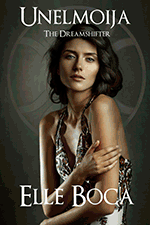by Editor | Jul 30, 2012 | Accomodations, Attractions, Food and Wine
Article and photos by Elena del Valle

Katherine in class
In late April, I traveled to Burgundy, France for a six-night introductory cooking and culinary small group program with some behind-the-scenes features. Included in the English language program were comfortable and modern accommodations with daily room cleaning, meals, cooking demonstrations, transportation and activities with English speaking guides (a service tip was suggested though not required). As part of the program six of us shared Frelon’s Fabulous France, a five bedroom two-story recently renovated house with a working fireplace, complimentary WiFi connectivity, a private swimming pool and two enclosed courtyards (because of the cold that week the pool remained covered and the courtyards empty of guests).

Prime space at the kitchen counter
The house, formerly used as horse stables, had been lovingly renovated by the owners, Katherine and Yannick Frelon, over an intensive 18 month period. The culinary program was led by Katherine, an English cook, and a group of her associates from the same country. It consisted of her cooking demonstrations with some hands on cooking opportunities for those so inclined, daily culinary or wine related excursions, and three non home cooked meals (one a la carte cafe lunch and two set menu gourmet restaurant meals, one lunch and one dinner).
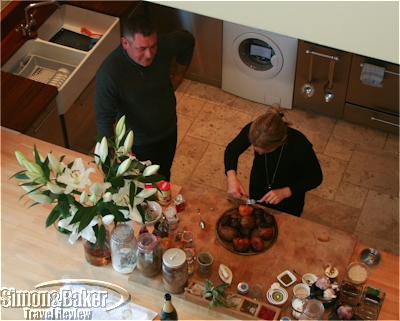
Katherine and Yannick in the kitchen
The house itself, especially the kitchen, was well appointed, spacious and comfortable. Located in Marigny Le Cahouet, a pretty and quiet country village fronting a brook and the famed Burgundy Canal, it provided a placid setting in spite of a rain filled week. The upside of the weather were the uncrowded Dijon market and tourist attractions we visited.

One of Katherine’s many dishes
Katherine, a part-time river barge and freelance cook who had lived in France for many years, dedicated time on four days to cooking demonstrations which resulted in lunch buffets and plated dinners for our group. The meals were prepared from regional fresh ingredients (some from her garden) by her, while we watched and sometimes participated, from her own recipes which she provided in a 72-page printed spiral bound handout on our arrival. Her cooking style, she explained when I asked at the conclusion of the week, is “seasonal, local, fresh and inspired” with recipes designed to translate to cooking students homes on their return to their country of residence.

Our first activity was a wine tasting
At the beginning of the week, we were provided with a final itinerary without times or activity duration. Katherine would inform us of times and durations just before the activities on a daily basis or by leaving a printed card atop the kitchen counter. We ate most meals in the house dining room on the ground floor. Breakfast and lunch were self service buffet style and dinner was prepared and plated in the kitchen and served by Katherine or an assistant at the dinner table. Meal times varied depending on the day’s activities. A continental breakfast (hot beverages, self squeezed orange juice, bread, deli meats, cheeses, fresh fruit, yogurt, cold cereal, honey and jams) was usually available an hour or less before departure; lunch was usually served between 1 p.m. and 2:30 p.m. Dinner, usually after 8 p.m., lasted two or more hours.

Katherine demonstrated a cooking technique in class
Our days, spent mostly in each other’s company and with Katherine or a guide, were busier than I had anticipated. From breakfast through the end of dinner the majority of our waking hours were taken up by cooking demonstrations, scheduled activities or meals. That week I was reminded that spending time in close quarters with strangers with varied cultural and social backgrounds may be challenging. At times some of the attitudes and behaviors of other guests, particularly those who seemed to monopolize the conversation, complain and make unsolicited and unwelcome critical remarks, were grating and more than once spoiled the moment.
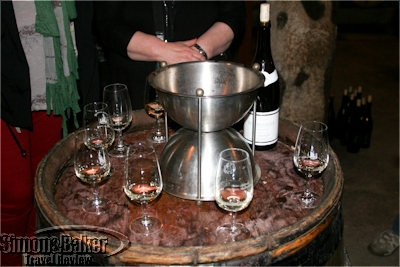
There were several wine tasting opportunities
During the week, there were two wine activities with different guides and visits with tastings to three small family owned wine makers. My favorite experiences by far were the introduction to Burgundy wines by Nancy, a knowledgeable Englishwoman with a ready smile, the first afternoon; and the behind the scenes visit and wine tasting at a Flavigny winery also in her company.

A stop at the Maille mustard shop in Dijon was included
There was a kitchen side cooking demonstration with guest participation at a gourmet restaurant, a visit to Dijon focusing on a market experience and cafe break, a mustard shop stop, a croissant making demonstration by the village baker in the house, and a chocolate shop visit with complimentary hot cocoa and a couple of bite size samples.

Ingredients for a recipe
On our last full day we went to two wine tastings. We also stopped in Beaune for a light lunch at a central cafe, an optional 30-minute visit with our wine guide to the Hospice de Beaune, a historic building and popular tourist attraction, and an hour at leisure for shopping enthusiasts (most of the shops were closed for 30 minutes of that time).

Hot cocoa at the Comptoir des Colonies near the Dijon market
The day after our arrival we drove to a gourmet restaurant in a pretty vineyard setting for a cooking demonstration with the chef followed by a kitchen-side lunch (not a favorite). Unfortunately the chef was in Singapore so the demonstration was conducted in English by one of his staff cooks, a personable Asian woman. Some of the ingredients were unavailable, she informed us at the beginning of the class and had to be substituted in the recipe. Although she tried several times she was unable to demonstrate the foam technique that was central to the recipe; instead of foam the device, when pressed, delivered liquid.

A visit of a cobble stoned street town
Our much anticipated final gourmet meal was at a highly rated restaurant about 30 minutes from the house. On our arrival we were greeted, in charming French accented English, by the owner. Although the restaurant dining room where we were seated faced a lovely garden, our corner table was near the rear of the room rather than the window and my seat faced the wall. A flute of champagne unexpectedly flavored with pear and laurel and a warm cheese pastry amouse bouche distracted me from my initial disappointment of the view. The highlight of the set dinner menu with two house wines was a raw shrimp appetizer and a well cooked river fish. The pigeon was well prepared and presented. I especially liked the tiny but savory thighbone.

Bubbly was on offer in the afternoons
Following dessert the restaurant manager graciously invited us to the kitchen to meet the chef. While we enjoyed hot beverages in a lounge at the dining room entrance we were presented with a copy each of our menu with photos taken during our brief kitchen visit on the front cover as a memento of the night’s dinner, the closing activity for the week. By midnight we were back at the house and I was busy preparing for my early morning departure to catch the only daily train to the Charles de Gaulle Airport at the nearby Montbard station, a 20-minute drive from the house.

Cassoulet, one of my favorite dishes that week
I would recommend La Ferme de la Lochere (6 Rue de la Lochere, 21150 Marigny Le Cahouet, France, +33 672 86 5609, http://lafermedelalochere.com, katherine.frelon@lafermedelalochere.com) Burgundy culinary program to friends and acquaintances seeking an introduction to culinary Burgundy, related cooking demonstrations and behind-the-scenes activities with an English cook and team, in particular to groups wishing to book the program exclusively or to rent the house.
by Editor | Jul 16, 2012 | Food and Wine
By Elena del Valle
Photos by Gary Cox

Copper color lamps hung above the bar counter
We first patronized Gorgeous by Graham Beck soon after its opening during a stay at Steenberg hotel in Constantia in the outskirts of Cape Town, South Africa. Before dinner at Catharina’s, the hotel restaurant located in the same building as Gorgeous, we stopped by to see what all the fuss was about and sample for ourselves some of the tapas and Graham Beck bubbly on offer. When we arrived a handful of guests were scattered in the cozy corners of the Method Cap Classique bar with room for 25 guests. As bubbly aficionados we thoroughly enjoyed our flight and canape tasting and plan to return at the first opportunity.

Our server, Zelda Pretorius
Zelda Pretorius, our server, was welcoming and knowledgeable. She explained, with hard to conceal enthusiasm, the varieties of sparkling wine on offer, all from producer Graham Beck who owned the Steenberg Estate including Gorgeous. Options included vintage and non vintage wines by the glass (125 milliliters or 50 milliliters for tasting menu items) priced between 40 rand and 85 rand per person and by the bottle ranging between 200 rand and 500 rand for each bottle.

A tasting selection of Graham Beck sparkling wines
Aging in the rack of the pinot noir and chardonnay wines ranged between 18 months and 36 months except for the Cuvee Clive 2005, named for Graham Beck’s son and our favorite after a through tasting of seven wines, which had aged five years. The Blanc de Blanc was 100 percent chardonnay, Zelda explained. The Brut Zero was 85 percent chardonnay and 15 pinot noir. In terms of sweetness, there were marked differences between the wines. For example, there were 38 grams of sugar per liter in the Demi and only 2.4 grams of sugar in the Brut Zero; there were 12 grams in the Brut Rose 2009, 8 grams in the Blanc de Blanc and non vintage offerings.

The sparkling wine was expertly served
Bubbly tasting options were by the glass or by the flight. The flight options offered three wines each for non vintage (Brut NV, Brut Rose NV, and Bliss NV) and vintage (Blanc de Blancs 2008, Brut Rose 2009, Brut Zero 2005), and two for rose (Brut Rose NV and Brut Rose 2009). We sampled two flights and a glass of Cuvee Clive 2005.

A selection of canapes rounded out the tasting
To accompany our tasting we sampled a platter of five canape appetizers from Catharina’s kitchen next door. It came with bite size morsels of mushroom and rice, salmon trout and salmon roe, quail egg, oyster and tiger prawn with avocado.

The Gorgeous bubbly bar
While we awaited the arrival of our order I glanced around curious to observe details of the built-in sections and bar seating that made up the bubbly bar. It was decorated in muted metallic colors with a refined yet youthful designer tone. The bar counter was made of marble by Green Way Interiors and the floor had marble mosaic tiles by Kenzan Tiles. Wallpapered walls, copper color lamps hanging above the bar counter and module division lent depth to the space. Gorgeous by Graham Beck, 10802 Steenberg Estate, Tokai Road, Tokai 7945, +27 21 713 7177, www.gorgeousbygrahambeck.com, info@gorgeousbygrahambeck.co.za
by Editor | Sep 12, 2011 | Accomodations, Ecotourism, Food and Wine, New Articles
By Elena del Valle
Photos by Gary Cox and Elena del Valle

The suite at Boulders featured a stunning view of the bush
We ended our visit to South Africa’s premier game viewing area earlier this year with three nights at the Singita properties in the Sabi Sand Reserve. We spent the first two nights at Singita Ebony and the last night, the first night they were open following a soft refurbishing closure, at Singita Boulders. Our experience was superb.
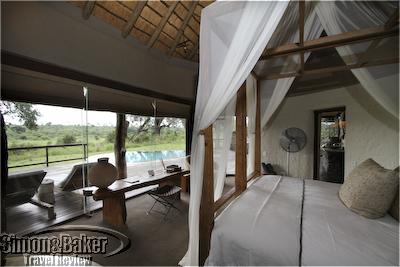
The master bedroom and private pool at Singita Boulders

The master bedroom at Boulders featured a wood burning fireplace
At Ebony we enjoyed an informative and fun wine tasting with Francois Rautenbach, the company’s wine manager, in the lodge’s cozy cellar. During the hour long event, shared with four other guests, we heard about South Africa’s varied wine regions and the wines they produce, the evolution of the country’s wine industry and some of the salient wines that are garnering international recognition.

Francois Rautenbach, Singita’s wine manager
During the tasting, we had a chance to sample four wines, selected by the staff, before our tasting menu dinner. We began with a 2008 Director’s Reserve White from Tokara in Simonsberg-Stellenbosch made of 85 percent sauvignon blanc and 15 percent semillon and a 2009 Aeternitas Wines Blanc from Voor-Paardeberg made of 90 chenin blanc, 5 percent viognier and 5 percent grenache blanc.

The Singita shop carried wine and related merchandise
Next we had two 2003 wines, a Sequillo Cellars blend of syrah, mourvedre and grenache from the West Coast and Paarl regions and a Rij’s Private Cellar Bravado blend of 21 percent cabernet, 7 percent cabernet franc, 12 percent merlot, 35 percent shiraz and 25 percent pinotage from the Tulbagh Valley.

Singita staff prepared an eco-friendly meal by lantern light
At Boulders we joined fellow guests and the lodge staff, at the same time as guests and staff at Singita’s nine lodges in three countries, in an Earth Hour global event organized by the World Wide Fund for Nature on the last Saturday of March every year. The idea is to make it through one hour in the early evening without electricity to raise awareness about climate change.

The dining area on the main deck prepared for Earth Hour
The local staff regaled us with a singing and dance performance and the kitchen made sure our dinner, prepared on the deck and served by candlelight was splendid. A company executive and a local news media team were on hand to share the moment with viewers across the country. Visit the Simon & Baker Travel Review for more about Singita Boulders and our visit to the Sabi Sand Reserve and Singita Ebony.
by Editor | Apr 5, 2010 | Accomodations, Ecotourism, Food and Wine, New Articles
By Elena del Valle, photos by Gary Cox
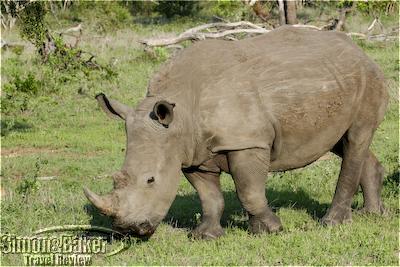
A white rhino at the Royal Malewane

A relaxing corner of our suite’s private outdoor deck at the Royal Malewane
When I mention South Africa to people who haven’t been there I get one of two reactions, fear or excitement. Fear because of the country’s reputation for crime and excitement because it sounds exotic and fun to visit. For those who know about game viewing Africa’s southernmost nation is synonymous with luxury safaris. Others still are aware of the country’s nascent wine industry and gourmet inclination. Game viewing and visits to the wine region, to a lesser extent, are some of the main reasons international travelers find their way to South Africa.
For those willing to overlook the hateful crime statistics and brave the long flights to reach the far corner of the African continent the rewards are plentiful and an excellent value for money. Visitors with the means and desire to travel in style will find there are many luxurious accommodations to choose from including five-star hotels, lodges, and tented camps. When planning a trip, selecting an area of topical or geographic interest is a good first step. For some a familiar name, such as a chain hotel, may be reassuring.
Another possibility for the more adventurous is a boutique property. For guests wishing to sample a less uniform and more local experience small properties like lodges, camps and boutique hotels can be a godsend. Often these types of properties offer attentive customer centered service and many advantages over the larger hotels. Over time we’ve discovered several outstanding properties owned by the same company or family in various parts of the country offering excellent and distinctive luxury accommodations.

The inner courtyard with two pools at Birkenheadhouse


Views from the deck at Birkenheadhouse
An example of this is three properties that form The Royal Portfolio owned by Liz and Phil Biden. The couple successfully converted their vacation homes in different parts of South Africa into small luxury lodges. We have visited the three properties on two separate occasions. First, we were at the Royal Malewane and on our most recent trip we visited Birkenheadhouse and La Residence. Each is distinctive and has its own attractions.
We especially appreciated the outstanding service, comfort and luxury accommodations, attention to detail, superb whimsical décor, and strong foodie orientation they shared. They make an excellent circuit for those wishing to sample some of the best options South Africa has to offer for safari and whale watching destinations as well as for fine food and wine lovers.

A side view of the central courtyard at La Residence


The main building interior at La Residence

The romantic bathroom in the Hibiscus Suite
The Royal Malewane, an intimate luxury safari lodge with an on site spa near http://simonandbaker.com/kruger, has been host to international celebrities and politicos. Birkenheadhouse, a second property located in Hermanus on the coast east of Cape Town, is perched above the beach in a village known nationally for its seasonal whale watching opportunities. La Residence is our favorite for its over-the-top flair, beautiful setting within a farm estate and delicious meals. It is in the wine and gourmet town of Franschoek, a short drive from Cape Town.
by Editor | Jan 18, 2010 | Accomodations, Food and Wine, New Articles
By Elena del Valle and photos by Gary Cox
A quiet corner at Asara near the reception
The Sansibar Cigar and Whiskey Lounge
We arrived at Asara Wine Estate and Hotel, a small luxury and gourmet oriented hotel and wine producing property just outside the college city of Stellenbosch in South Africa’s wine region, in early spring. Although there was a definite chill in the air the days were beautiful. There were just enough puffy clouds in the perfect blue sky to make it interesting and the view of the property from our rooms was lovely. It was hard to imagine that the quiet country setting was only 25 minutes away from the airport and not much further from bustling Cape Town.
A hearty seafood lunch dish at Asara
We like that Asara is friendly to the environment. The company practices eco-sensitive biodynamic wine production to reduce the environmental impact of its operations as well as other efforts to offset the estate’s carbon footprint. Solar panels are part of the wine production process. All wine bottles and glassware on the estate are recycled.
More than 400 indigenous pin oaks trees were planted to aid oxygen production. Plans are in place to remove all alien plants from the estate by 2011. At the same time, organic waste from the restaurants and cellar is used for organic compost and the four dams in the farm are used for irrigation. No harmful chemicals are used for pest control.
Perhaps these efforts are paying off with wildlife. Recently, two new litters of endangered caracal (a fast small to medium cat similar to the serval) were seen around the estate, along with the grysbokkies, duikers and guinea fowl that the farm their home.
As a visitor what first comes to mind when I think of the 37-room Relais and Chateaux property is the view of the vineyards, a pond and mountains in the background from our table at Raphael’s, the hotel’s gourmet restaurant. We enjoyed the comfortable and well appointed accommodations and facilities and food and wine opportunities and would gladly return. Click here to read about our visit to Asara.
by Editor | Nov 9, 2009 | Accomodations, Food and Wine, New Articles
Article and photos by Josette King

Altesino Estate in Tuscany
This was la dolce vita at its best. Not the Fellini kind with dark-of-night Vespa races through the streets of Rome and impromptu dips in Bernini fountains but a leisurely discovery of the famed cultural and natural wonders of Tuscany. Our recent journey into the sweet life began in Florence where we lingered for a week, taking in the flavor of the city and its lesser frequented artistic gems as well as the world-renowned guidebook “must” sites.
We then headed south to the province of Siena and our base for the second week of our Tuscan holiday at Le Capanne, a luxury villa near the ancient hamlet of Camporsevoli on the border with Umbria, the neighboring state. From there we motored along back roads of the Chianti and Val d’Orcia, our daily explorations taking us to famed medieval cities such as Siena, Montepulciano and Bagno Vignoni, feasting our eyes along the way on rolling hills covered with quilts of vineyards, meadows and olive groves.
While we could have planned a satisfying trip using the extensive material available to potential tourists, a truly memorable escapade required the assistance of a local whose help and suggestions ensured that we experienced not only the sites but the very essence of Tuscany. Valentina Grossi, founder and manager of One Step Closer, a customized luxury tour company in Florence, was our local contact. She focused on our special areas of interests to create memorable adventures.

Silvana Vivoli, scoops out a batch of Crema, the shop's most popular gelato

Vivoli gelati have delighted customers for 80 years
When I confessed my addiction to gelato, the decadently rich semi-soft Italian ice cream, Valentina was not content to recommend a visit to Vivoli (considered for several decades one the best gelaterias in Florence). Rather she arranged a visit with Silvana Vivoli, the grand-daughter of founder Raffaello Vivoli and current owner. We met in her laboratory where I spent a blissful hour discussing with her the finer points of gelato-making and sampling the elegant flavors that emerged from her slow-churning stainless steel centrifuges.

The Altesino Estate produces the famed Brunello di Montalcino

A record of the best vintages is kept in the Altesino library
Personal friendships dating back several generations between Valentina’s family and the owners of private art collections, landmark palazzi and exclusive wineries opened doors to experiences usually unknown to tourists. In Valentina’s company, we were welcomed by Maria Vittoria Corti Grazzi, current owner of Palazzo Peruzzi. The palace, located a few steps away from the Piazza Santa Croce, is the last privately owned palace of the Peruzzi family, a Florentine dynasty reaching back to the 14th century. In addition to a private viewing of her eclectic art collection ranging from Roman sarcophagi and Byzantine icons to a number of Florentine 17th century paintings, Maria Vittoria graciously led us on a tour of the beautifully decorated reception rooms of her palazzo.
The following week, aware of my keen interest in enology, Valentina arranged a private visit of Altesino, an esteemed boutique winery in Montalcino, where Managing Director Guido Orzalesi guided us through the entire production cycle of their superb Brunello and Rosso di Montalcino wines before treating us to a sumptuous luncheon and tasting of Altesino’s prized vintages. Even in Italy, life doesn’t get any sweeter! Click here for more about my visit to Tuscany and stay at Le Capanne at Camporsevoli.













































